2. Nicolle LE, Bradley S, Colgan R, Rice JC, Schaeffer A, Hooton TM. Infectious Diseases Society of America. American Society of Nephrology; American Geriatric Society. Infectious Diseases Society of America guidelines for the diagnosis and treatment of asymptomatic bacteriuria in adults. Clin Infect Dis. 2005; 40:643–654. PMID:
15714408.
3. Grabe M, Bartoletti R, Bjerklund-Johansen TE, Cai T, Çek M, Köves B, Naber KG, Pickard RS, Tenke P, Wagenlehner F, Wullt B. Guidelines on urological infections. Accessed 7 July 2017. Available at:
https://uroweb.org/wp-content/uploads/19-Urological-infections_LR2.pdf.
4. Dull RB, Friedman SK, Risoldi ZM, Rice EC, Starlin RC, Destache CJ. Antimicrobial treatment of asymptomatic bacteriuria in noncatheterized adults: a systematic review. Pharmacotherapy. 2014; 34:941–960. PMID:
24807583.

5. Nicolle LE. Asymptomatic bacteriuria. Curr Opin Infect Dis. 2014; 27:90–96. PMID:
24275697.

6. Nicolle LE. The paradigm shift to non-treatment of asymptomatic bacteriuria. Pathogens. 2016; 5:E38. PMID:
27104571.

7. Bengtsson C, Bengtsson U, Björkelund C, Lincoln K, Sigurdsson JA. Bacteriuria in a population sample of women: 24-year follow-up study. Results from the prospective population-based study of women in Gothenburg, Sweden. Scand J Urol Nephrol. 1998; 32:284–289. PMID:
9764457.
8. Evans DA, Williams DN, Laughlin LW, Miao L, Warren JW, Hennekens CH, Shimada J, Chapman WG, Rosner B, Taylor JO. Bacteriuria in a population-based cohort of women. J Infect Dis. 1978; 138:768–773. PMID:
368263.

9. Jeon MH, Park WB, Kim SR, Chun HK, Han SH, Bang JH, Park ES, Jeong SY, Eom JS, Kim YK, Kim HB, Lee KY, Choi HJ, Kim HY, Kim KM, Sung JH, Uh Y, Chung HS, Kwon JW, Woo JH. Korean nosocomial infections surveillance system, intensive care unit module report: data summary from July 2010 through June 2011. Korean J Nosocomial Infect Control. 2012; 17:28–39.
10. Shin JC, Yoo JH, Park JW, Park S, Ahn SJ, Park CI. Difference of organism and their antibiotics sensitivity from urine culture in symptomatic urinary tract infection of spinal cord injury patients. J Korean Acad Rehabil Med. 2008; 32:38–44.
11. Smaill FM, Vazquez JC. Antibiotics for asymptomatic bacteriuria in pregnancy. Cochrane Database Syst Rev. 2015; (8):CD000490. PMID:
26252501.

12. Kazemier BM, Koningstein FN, Schneeberger C, Ott A, Bossuyt PM, de Miranda E, Vogelvang TE, Verhoeven CJ, Langenveld J, Woiski M, Oudijk MA, van der Ven JE, Vlegels MT, Kuiper PN, Feiertag N, Pajkrt E, de Groot CJ, Mol BW, Geerlings SE. Maternal and neonatal consequences of treated and untreated asymptomatic bacteriuria in pregnancy: a prospective cohort study with an embedded randomised controlled trial. Lancet Infect Dis. 2015; 15:1324–1333. PMID:
26255208.

13. Angelescu K, Nussbaumer-Streit B, Sieben W, Scheibler F, Gartlehner G. Benefits and harms of screening for and treatment of asymptomatic bacteriuria in pregnancy: a systematic review. BMC Pregnancy Childbirth. 2016; 16:336. PMID:
27806709.

14. Cai T, Mazzoli S, Mondaini N, Meacci F, Nesi G, D'Elia C, Malossini G, Boddi V, Bartoletti R. The role of asymptomatic bacteriuria in young women with recurrent urinary tract infections: to treat or not to treat? Clin Infect Dis. 2012; 55:771–777. PMID:
22677710.

15. Cai T, Nesi G, Mazzoli S, Meacci F, Lanzafame P, Caciagli P, Mereu L, Tateo S, Malossini G, Selli C, Bartoletti R. Asymptomatic bacteriuria treatment is associated with a higher prevalence of antibiotic resistant strains in women with urinary tract infections. Clin Infect Dis. 2015; 61:1655–1661. PMID:
26270684.

16. Boscia JA, Kobasa WD, Knight RA, Abrutyn E, Levison ME, Kaye D. Therapy vs no therapy for bacteriuria in elderly ambulatory nonhospitalized women. JAMA. 1987; 257:1067–1071. PMID:
3806896.

17. Abrutyn E, Mossey J, Berlin JA, Boscia J, Levison M, Pitsakis P, Kaye D. Does asymptomatic bacteriuria predict mortality and does antimicrobial treatment reduce mortality in elderly ambulatory women? Ann Intern Med. 1994; 120:827–833. PMID:
7818631.

18. Nicolle LE, Mayhew WJ, Bryan L. Prospective randomized comparison of therapy and no therapy for asymptomatic bacteriuria in institutionalized elderly women. Am J Med. 1987; 83:27–33.

19. Ouslander JG, Schapira M, Schnelle JF, Uman G, Fingold S, Tuico E, Nigam JG. Does eradicating bacteriuria affect the severity of chronic urinary incontinence in nursing home residents? Ann Intern Med. 1995; 122:749–754. PMID:
7717597.

20. Harding GK, Zhanel GG, Nicolle LE, Cheang M. Manitoba Diabetes Urinary Tract Infection Study Group. Antimicrobial treatment in diabetic women with asymptomatic bacteriuria. N Engl J Med. 2002; 347:1576–1583. PMID:
12432044.

21. Dalal S, Nicolle L, Marrs CF, Zhang L, Harding G, Foxman B. Long-term
Escherichia coli asymptomatic bacteriuria among women with diabetes mellitus. Clin Infect Dis. 2009; 49:491–497. PMID:
19583518.
22. Mohler JL, Cowen DL, Flanigan RC. Suppression and treatment of urinary tract infection in patients with an intermittently catheterized neurogenic bladder. J Urol. 1987; 138:336–340. PMID:
3496470.

23. Maynard FM, Diokno AC. Urinary infection and complications during clean intermittent catheterization following spinal cord injury. J Urol. 1984; 132:943–946. PMID:
6333518.

24. Harding GK, Nicolle LE, Ronald AR, Preiksaitis JK, Forward KR, Low DE, Cheang M. How long should catheter-acquired urinary tract infection in women be treated? a randomized controlled study. Ann Intern Med. 1991; 114:713–719. PMID:
2012351.
25. Warren JW, Anthony WC, Hoopes JM, Muncie HL Jr. Cephalexin for susceptible bacteriuria in afebrile, long-term catheterized patients. JAMA. 1982; 248:454–458. PMID:
7045440.

26. Leone M, Perrin AS, Granier I, Visintini P, Blasco V, Antonini F, Albanèse J, Martin C. A randomized trial of catheter change and short course of antibiotics for asymptomatic bacteriuria in catheterized ICU patients. Intensive Care Med. 2007; 33:726–729. PMID:
17294169.

27. Hooton TM, Bradley SF, Cardenas DD, Colgan R, Geerlings SE, Rice JC, Saint S, Schaeffer AJ, Tambayh PA, Tenke P, Nicolle LE. Infectious Diseases Society of America. Diagnosis, prevention, and treatment of catheter-associated urinary tract infection in adults: 2009 International Clinical Practice Guidelines from the Infectious Diseases Society of America. Clin Infect Dis. 2010; 50:625–663. PMID:
20175247.

28. Grabe M, Forsgren A, Björk T, Hellsten S. Controlled trial of a short and a prolonged course with ciprofloxacin in patients undergoing transurethral prostatic surgery. Eur J Clin Microbiol. 1987; 6:11–17. PMID:
3569248.

29. Olsen JH, Friis-Møller A, Jensen SK, Korner B, Hvidt V. Cefotaxime for prevention of infectious complications in bacteriuric men undergoing transurethral prostatic resection. A controlled comparison with methenamine. Scand J Urol Nephrol. 1983; 17:299–301. PMID:
6196841.
30. Grabe M, Forsgren A, Hellsten S. The effect of a short antibiotic course in transurethral prostatic resection. Scand J Urol Nephrol. 1984; 18:37–42. PMID:
6202000.

31. Allan WR, Kumar A. Prophylactic mezlocillin for transurethral prostatectomy. Br J Urol. 1985; 57:46–49. PMID:
3971104.

32. Rao PN, Dube DA, Weightman NC, Oppenheim BA, Morris J. Prediction of septicemia following endourological manipulation for stones in the upper urinary tract. J Urol. 1991; 146:955–960. PMID:
1895450.

33. Cafferkey MT, Falkiner FR, Gillespie WA, Murphy DM. Antibiotics for the prevention of septicaemia in urology. J Antimicrob Chemother. 1982; 9:471–477. PMID:
7107549.

34. Nicolle LE. Uncomplicated urinary tract infection in adults including uncomplicated pyelonephritis. Urol Clin North Am. 2008; 35:1–12. vPMID:
18061019.

35. Health Insurance Review & Assessment service (HIRA). In-depth analysis of drug consumption. Wonju: HIRA;2015.
36. Mazzulli T. Resistance trends in urinary tract pathogens and impact on management. J Urol. 2002; 168:1720–1722. PMID:
12352343.

37. Lee SJ, Lee DS, Choe HS, Shim BS, Kim CS, Kim ME, Cho YH. Antimicrobial resistance in community-acquired urinary tract infections: results from the Korean Antimicrobial Resistance Monitoring System. J Infect Chemother. 2011; 17:440–446. PMID:
21140281.
38. Kim B, Kim J, Wie SH, Park SH, Cho YK, Lim SK, Shin SY, Yum JS, Lee JS, Kweon KT, Lee H, Cheong HJ, Park DW, Ryu SY, Chung MH, Pai H. Is it acceptable to select antibiotics for the treatment of community-acquired acute cystitis based on the antibiotics susceptibility results for uropathogens from community-acquired acute pyelonephritis in Korea? Infect Chemother. 2012; 44:269–274.

39. Lee SJ, Lee SD, Cho IR, Sim BS, Lee JG, Kim CS, Kim ME, Cho YH, Woo YN. Antimicrobial susceptibility of uropathogens causing acute uncomplicated cystitis in female outpatients in South Korea: a multicentre study in 2002. Int J Antimicrob Agents. 2004; 24(Suppl 1):S61–S64. PMID:
15364310.

40. Kim ME, Ha US, Cho YH. Prevalence of antimicrobial resistance among uropathogens causing acute uncomplicated cystitis in female outpatients in South Korea: a multicentre study in 2006. Int J Antimicrob Agents. 2008; 31(Suppl 1):S15–S18. PMID:
18096373.

41. Kim HY, Lee SJ, Lee DS, Yoo JM, Choe HS. Microbiological characteristics of unresolved acute uncomplicated cystitis. Microb Drug Resist. 2016; 22:387–391. PMID:
26780182.

42. Kim WB, Cho KH, Lee SW, Yang HJ, Yun JH, Lee KW, Kim JM, Kim YH, Jeon YS, Kim ME. Recent antimicrobial susceptibilities for uropathogenic Escherichia coli in patients with community acquired urinary tract infections: a multicenter study. Urogenit Tract Infect. 2017; 12:28–34.
43. Kim KY, Kim CS, Lim DH. The ciprofloxacin resistance pattern of Escherichia coli isolated from female patients with community-acquired urinary tract infection in the Jeonnam and Gwangju region for the recent 2-years. Korean J Urol. 2008; 49:540–548.
44. The Korean Society of Infectious Diseases, The Korean Society for Chemotherapy, Korean Association of Urogenital Tract Infection and Inflammation, The Korean Society of Clinical Microbiology. Clinical guideline for the diagnosis and treatment of urinary tractiInfections: asymptomatic bacteriuria, uncomplicated & complicated urinary tract infections, bacterial prostatitis. Infect Chemother. 2011; 43:1–25.
45. Bent S, Nallamothu BK, Simel DL, Fihn SD, Saint S. Does this woman have an acute uncomplicated urinary tract infection? JAMA. 2002; 287:2701–2710. PMID:
12020306.

46. Rowe TA, Juthani-Mehta M. Diagnosis and management of urinary tract infection in older adults. Infect Dis Clin North Am. 2014; 28:75–89. PMID:
24484576.

47. Simerville JA, Maxted WC, Pahira JJ. Urinalysis: a comprehensive review. Am Fam Physician. 2005; 71:1153–1162. PMID:
15791892.
48. Rubin RH, Shapiro ED, Andriole VT, Davis RJ, Stamm WE. Evaluation of new anti-infective drugs for the treatment of urinary tract infection. Infectious Diseases Society of America and the Food and Drug Administration. Clin Infect Dis. 1992; 15(Suppl 1):S216–S227. PMID:
1477233.
49. Zalmanovici Trestioreanu A, Green H, Paul M, Yaphe J, Leibovici L. Antimicrobial agents for treating uncomplicated urinary tract infection in women. Cochrane Database Syst Rev. 2010; (10):CD007182. PMID:
20927755.

50. Rafalsky V, Andreeva I, Rjabkova E. Quinolones for uncomplicated acute cystitis in women. Cochrane Database Syst Rev. 2006; (3):CD003597. PMID:
16856014.

52. Falagas ME, Vouloumanou EK, Togias AG, Karadima M, Kapaskelis AM, Rafailidis PI, Athanasiou S. Fosfomycin versus other antibiotics for the treatment of cystitis: a meta-analysis of randomized controlled trials. J Antimicrob Chemother. 2010; 65:1862–1877. PMID:
20587612.

53. Schito GC, Naber KG, Botto H, Palou J, Mazzei T, Gualco L, Marchese A. The ARESC study: an international survey on the antimicrobial resistance of pathogens involved in uncomplicated urinary tract infections. Int J Antimicrob Agents. 2009; 34:407–413. PMID:
19505803.

54. Zhanel GG, Walkty AJ, Karlowsky JA. Fosfomycin: a first-line oral therapy for acute uncomplicated cystitis. Can J Infect Dis Med Microbiol. 2016; 2016:2082693. PMID:
27366158.

55. Seo MR, Kim SJ, Kim Y, Kim J, Choi TY, Kang JO, Wie SH, Ki M, Cho YK, Lim SK, Lee JS, Kwon KT, Lee H, Cheong HJ, Park DW, Ryu SY, Chung MH, Pai H. Susceptibility of
Escherichia coli from community-acquired urinary tract infection to fosfomycin, nitrofurantoin, and temocillin in Korea. J Korean Med Sci. 2014; 29:1178–1181. PMID:
25120333.
56. Hooton TM, Roberts PL, Stapleton AE. Cefpodoxime vs ciprofloxacin for short-course treatment of acute uncomplicated cystitis: a randomized trial. JAMA. 2012; 307:583–589. PMID:
22318279.

57. Kavatha D, Giamarellou H, Alexiou Z, Vlachogiannis N, Pentea S, Gozadinos T, Poulakou G, Hatzipapas A, Koratzanis G. Cefpodoxime-proxetil versus trimethoprim-sulfamethoxazole for short-term therapy of uncomplicated acute cystitis in women. Antimicrob Agents Chemother. 2003; 47:897–900. PMID:
12604518.

58. Raz R, Rottensterich E, Leshem Y, Tabenkin H. Double-blind study comparing 3-day regimens of cefixime and ofloxacin in treatment of uncomplicated urinary tract infections in women. Antimicrob Agents Chemother. 1994; 38:1176–1177. PMID:
8067759.

59. Galkin VV, Malev IV, Dovgan' EV, Kozlov SN, Rafal'skiĭ VV. Efficacy and safety of cefixim and ciprofloxacin in acute cystitis (a multicenter randomized trial). Urologiia. 2011; (1):13–16.
60. Lee SJ, Ha US, Kim HW, Cho YH. Efficacy of cefcapene pivoxil for empirical therapy of acute uncomplicated cystitis. Infect Chemother. 2008; 40:162–166.

61. Sohn DW, Ha US, Seo HJ, Lee JY, Kim SW, Cho YH. In-vitro susceptibility study of oral antibiotics to Escherichia coli, isolated from acute uncomplicated cystitis in female outpatients. Infect Chemother. 2006; 38:140–145.
62. Roh KH, Yum JH, Yong D, Choi SH, Rhee JK, Yoo M, Lee K, Chong Y. In vitro activities of cefatrizine-clavulanic acid against gram-negative bacilli isolated from community-acquired urinary track infection. Korean J Lab Med. 2005; 25:411–415.
63. Lee SY, Lee JH, Kim JH, Hur JK, Kim SM, Ma SH, Kang JH. Susceptibility tests of oral antibiotics including cefixime against Escherichia coli, isolated from pediatric patients with community-acquired urinary tract infections. Korean J Pediatr. 2006; 49:777–783.
64. Warren JW, Abrutyn E, Hebel JR, Johnson JR, Schaeffer AJ, Stamm WE. Guidelines for antimicrobial treatment of uncomplicated acute bacterial cystitis and acute pyelonephritis in women. Infectious Diseases Society of America (IDSA). Clin Infect Dis. 1999; 29:745–758. PMID:
10589881.
65. Kim JH, Sun HY, Kim TH, Shim SR, Doo SW, Yang WJ, Lee EJ, Song YS. Prevalence of antibiotic susceptibility and resistance of
Escherichia coli in acute uncomplicated cystitis in Korea: systematic review and meta-analysis. Medicine (Baltimore). 2016; 95:e4663. PMID:
27603359.
66. Pinart M, Kranz J, Jensen K, Proctor T, Naber K, Kunath F, Wagenlehner F, Schmidt S. Optimal dosage and duration of pivmecillinam treatment for uncomplicated lower urinary tract infections: a systematic review and meta-analysis. Int J Infect Dis. 2017; 58:96–109. PMID:
28341436.

67. Milo G, Katchman EA, Paul M, Christiaens T, Baerheim A, Leibovici L. Duration of antibacterial treatment for uncomplicated urinary tract infection in women. Cochrane Database Syst Rev. 2005; (2):CD004682. PMID:
15846726.

68. Lutters M, Vogt-Ferrier NB. Antibiotic duration for treating uncomplicated, symptomatic lower urinary tract infections in elderly women. Cochrane Database Syst Rev. 2008; (3):CD001535. PMID:
18646074.

69. Sadahira T, Wada K, Araki M, Ishii A, Takamoto A, Kobayashi Y, Watanabe M, Watanabe T, Nasu Y, Kumon H. Okayama Urological Research Group (OURG). Efficacy and safety of 3 day versus 7 day cefditoren pivoxil regimens for acute uncomplicated cystitis: multicentre, randomized, open-label trial. J Antimicrob Chemother. 2017; 72:529–534. PMID:
27733519.

70. Grigoryan L, Zoorob R, Wang H, Horsfield M, Gupta K, Trautner BW. Less workup, longer treatment, but no clinical benefit observed in women with diabetes and acute cystitis. Diabetes Res Clin Pract. 2017; 129:197–202. PMID:
28544925.

71. Katchman EA, Milo G, Paul M, Christiaens T, Baerheim A, Leibovici L. Three-day vs longer duration of antibiotic treatment for cystitis in women: systematic review and meta-analysis. Am J Med. 2005; 118:1196–1207. PMID:
16271900.

72. Lifshitz E, Kramer L. Outpatient urine culture: does collection technique matter? Arch Intern Med. 2000; 160:2537–2540. PMID:
10979067.
73. Bradbury SM. Collection of urine specimens in general practice: to clean or not to clean? J R Coll Gen Pract. 1988; 38:363–365. PMID:
3256648.
74. Barry HC, Ebell MH, Hickner J. Evaluation of suspected urinary tract infection in ambulatory women: a cost-utility analysis of office-based strategies. J Fam Pract. 1997; 44:49–60. PMID:
9010371.

75. Carlson KJ, Mulley AG. Management of acute dysuria. A decision-analysis model of alternative strategies. Ann Intern Med. 1985; 102:244–249. PMID:
3871318.
76. Foxman B. Epidemiology of urinary tract infections: incidence, morbidity, and economic costs. Dis Mon. 2003; 49:53–70. PMID:
12601337.

77. Kunin CM. Urinary tract infections in females. Clin Infect Dis. 1994; 18:1–10. PMID:
8054415.

78. Hooton TM. Clinical practice. Uncomplicated urinary tract infection. N Engl J Med. 2012; 366:1028–1037. PMID:
22417256.
79. Ki M, Park T, Choi B, Foxman B. The epidemiology of acute pyelonephritis in South Korea, 1997-1999. Am J Epidemiol. 2004; 160:985–993. PMID:
15522855.

80. Scholes D, Hooton TM, Roberts PL, Gupta K, Stapleton AE, Stamm WE. Risk factors associated with acute pyelonephritis in healthy women. Ann Intern Med. 2005; 142:20–27. PMID:
15630106.

81. Czaja CA, Hooton TM. Update on acute uncomplicated urinary tract infection in women. Postgrad Med. 2006; 119:39–45. PMID:
16913646.

82. Ramakrishnan K, Scheid DC. Diagnosis and management of acute pyelonephritis in adults. Am Fam Physician. 2005; 71:933–942. PMID:
15768623.
83. Efstathiou SP, Pefanis AV, Tsioulos DI, Zacharos ID, Tsiakou AG, Mitromaras AG, Mastorantonakis SE, Kanavaki SN, Mountokalakis TD. Acute pyelonephritis in adults: prediction of mortality and failure of treatment. Arch Intern Med. 2003; 163:1206–1212. PMID:
12767958.
84. Farrell DJ, Morrissey I, De Rubeis D, Robbins M, Felmingham D. A UK multicentre study of the antimicrobial susceptibility of bacterial pathogens causing urinary tract infection. J Infect. 2003; 46:94–100. PMID:
12634070.

85. Wie SH, Chang UI, Kim HW, Kim YS, Kim SY, Hur J, Kim SI, Kim YR, Kang MW. Clinical features and antimicrobial resistance among clinical isolates of women with community-acquired acute pyelonephritis in 2001-2006. Infect Chemother. 2007; 39:9–16.
86. Hwang BY, Lee JG, Park DW, Lee YJ, Kim SB, Eom JS, Sohn JW, Cheong HJ, Kim WJ, Kim MJ, Park SC. Antimicrobial susceptibility of causative microorganisms in adults with acute pyelonephritis at on Univeristy-affiliated hospital in southwestern Seoul. Infect Chemother. 2003; 35:277–282.
87. Wie SH, Choi SM, Lee DG, Kim SY, Kim SI, Yoo JH, Shin WS, Kang MW. Antibiotic sensitivity of the causative organisms and use of antibiotics in women with community-acquired acute pyelonephritis. Korean J Infect Dis. 2002; 34:353–359.
88. Lee HN, Yoon H. Management of antibiotic-resistant acute pyelonephritis. Urogenit Tract Infect. 2017; 12:95–102.

89. Kim B, Kim J, Seo MR, Wie SH, Cho YK, Lim SK, Lee JS, Kwon KT, Lee H, Cheong HJ, Park DW, Ryu SY, Chung MH, Ki M, Pai H. Clinical characteristics of community-acquired acute pyelonephritis caused by ESBL-producing pathogens in South Korea. Infection. 2013; 41:603–612. PMID:
23504297.

90. Sanchez GV, Master RN, Karlowsky JA, Bordon JM. In vitro antimicrobial resistance of urinary
Escherichia coli isolates among U.S. outpatients from 2000 to 2010. Antimicrob Agents Chemother. 2012; 56:2181–2183. PMID:
22252813.
91. Wie SH, Ki M, Kim J, Cho YK, Lim SK, Lee JS, Kwon KT, Lee H, Cheong HJ, Park DW, Ryu SY, Chung MH, Pai H. Clinical characteristics predicting early clinical failure after 72 h of antibiotic treatment in women with community-onset acute pyelonephritis: a prospective multicentre study. Clin Microbiol Infect. 2014; 20:O721–O729. PMID:
24330047.

92. Wie SH. Urinary tract infections. The Korean Society for Infectious Diseases. Infectious Diseases. 2nd ed. Seoul: Koonja Publishing Inc.;2014. p. 225–237.
94. Gupta K, Hooton TM, Naber KG, Wullt B, Colgan R, Miller LG, Moran GJ, Nicolle LE, Raz R, Schaeffer AJ, Soper DE. Infectious Diseases Society of America. European Society for Microbiology and Infectious Diseases. International clinical practice guidelines for the treatment of acute uncomplicated cystitis and pyelonephritis in women: A 2010 update by the Infectious Diseases Society of America and the European Society for Microbiology and Infectious Diseases. Clin Infect Dis. 2011; 52:e103–e120. PMID:
21292654.
95. Neumann I, Moore P. Pyelonephritis (acute) in non-pregnant women. BMJ Clin Evid. 2014; 2014:pii:0807.
96. Czaja CA, Scholes D, Hooton TM, Stamm WE. Population-based epidemiologic analysis of acute pyelonephritis. Clin Infect Dis. 2007; 45:273–280. PMID:
17599303.

97. van der Starre WE, van Dissel JT, van Nieuwkoop C. Treatment duration of febrile urinary tract infections. Curr Infect Dis Rep. 2011; 13:571–578. PMID:
21882085.

98. Jeon JH, Kim K, Han WD, Song SH, Park KU, Rhee JE, Song KH, Park WB, Kim ES, Park SW, Kim NJ, Oh MD, Kim HB. Empirical use of ciprofloxacin for acute uncomplicated pyelonephritis caused by Escherichia coli in communities where the prevalence of fluoroquinolone resistance is high. Antimicrob Agents Chemother. 2012; 56:3043–3046. PMID:
22391544.

99. Talan DA, Stamm WE, Hooton TM, Moran GJ, Burke T, Iravani A, Reuning-Scherer J, Church DA. Comparison of ciprofloxacin (7 days) and trimethoprim-sulfamethoxazole (14 days) for acute uncomplicated pyelonephritis pyelonephritis in women: a randomized trial. JAMA. 2000; 283:1583–1590. PMID:
10735395.
100. Stamm WE, McKevitt M, Counts GW. Acute renal infection in women: treatment with trimethoprim-sulfamethoxazole or ampicillin for two or six weeks. A randomized trial. Ann Intern Med. 1987; 106:341–345. PMID:
3492950.
101. Klausner HA, Brown P, Peterson J, Kaul S, Khashab M, Fisher AC, Kahn JB. A trial of levofloxacin 750 mg once daily for 5 days vs. ciprofloxacin 400 mg and/or 500 mg twice daily for 10 days in the treatment of acute pyelonephritis. Curr Med Res Opin. 2007; 23:2637–2645. PMID:
17880755.
102. Talan DA, Klimberg IW, Nicolle LE, Song J, Kowalsky SF, Church DA. Once daily, extended release ciprofloxacin for complicated urinary tract infections and acute uncomplicated pyelonephritis. J Urol. 2004; 171:734–739. PMID:
14713799.

103. Cronberg S, Banke S, Bergman B, Boman H, Eilard T, Elbel E, Hugo-Persson M, Johansson E, Kuylenstierna N, Lanbeck P, Lindblom A, Paulsen O, Schönbeck C, Walder M, Wieslander P. Fewer bacterial relapses after oral treatment with norfloxacin than with ceftibuten in acute pyelonephritis initially treated with intravenous cefuroxime. Scand J Infect Dis. 2001; 33:339–343. PMID:
11440218.
104. Wagenlehner FM, Weidner W, Naber KG. An update on uncomplicated urinary tract infections in women. Curr Opin Urol. 2009; 19:368–374. PMID:
19451818.

105. Sandberg T, Skoog G, Hermansson AB, Kahlmeter G, Kuylenstierna N, Lannergård A, Otto G, Settergren B, Ekman GS. Ciprofloxacin for 7 days vs. 14 days in women with acute pyelonephritis: a randomised, open-label and double-blind, placebo-controlled, non-inferiority trial. Lancet. 2012; 380:484–490. PMID:
22726802.
106. van Nieuwkoop C, van der Starre WE, Stalenhoef JE, van Aartrijk AM, van der Reijden TJ, Vollaard AM, Delfos NM, van 't Wout JW, Blom JW, Spelt IC, Leyten EM, Koster T, Ablij HC, van der Beek MT, Knol MJ, van Dissel JT. Treatment duration of febrile urinary tract infection: a pragmatic randomized, double-blind, placebo-controlled non-inferiority trial in men and women. BMC Med. 2017; 15:70. PMID:
28366170.

107. Chang UI, Kim HW, Wie SH. Use of cefuroxime for women with community-onset acute pyelonephritis caused by cefuroxime-susceptible or -resistant
Escherichia coli
. Korean J Intern Med. 2016; 31:145–155. PMID:
26767868.
108. Chang UI, Kim HW, Wie SH. Comparison of second- and third-generation cephalosporin as initial therapy for women with community-onset uncomplicated acute pyelonephritis. Yonsei Med J. 2015; 56:1266–1273. PMID:
26256969.

109. Bader MS, Loeb M, Brooks AA. An update on the management of urinary tract infections in the era of antimicrobial resistance. Postgrad Med. 2017; 129:242–258. PMID:
27712137.

110. Ipekci T, Seyman D, Berk H, Celik O. Clinical and bacteriological efficacy of amikacin in the treatment of lower urinary tract infection caused by extended-spectrum beta-lactamase-producing
Escherichia coli or
Klebsiella pneumoniae
. J Infect Chemother. 2014; 20:762–767. PMID:
25179392.
111. Pietrucha-Dilanchian P, Hooton TM. Diagnosis, treatment, and prevention of urinary tract infection. Microbiol Spectr. 2016; 4:UTI-0021–UTI-2015.

112. Veve MP, Wagner JL, Kenney RM, Grunwald JL, Davis SL. Comparison of fosfomycin to ertapenem for outpatient or step-down therapy of extended-spectrum beta-lactamase urinary tract infections. Int J Antimicrob Agents. 2016; 48:56–60. PMID:
27234673.
113. Tamma PD, Girdwood SC, Gopaul R, Tekle T, Roberts AA, Harris AD, Cosgrove SE, Carroll KC. The use of cefepime for treating AmpC β-lactamase-producing Enterobacteriaceae. Clin Infect Dis. 2013; 57:781–788. PMID:
23759352.

114. Wagenlehner FM, Sobel JD, Newell P, Armstrong J, Huang X, Stone GG. Yates K, Gasink LB. Ceftazidime-avibactam versus doripenem for the treatment of complicated urinary tract infections, including acute pyelonephritis: RECAPTURE, a phase 3 randomized trial program. Clin Infect Dis. 2016; 63:754–762. PMID:
27313268.
115. Wagenlehner FM, Umeh O, Steenbergen J, Yuan G, Darouiche RO. Ceftolozane-tazobactam compared with levofloxacin in the treatment of complicated urinary-tract infections, including pyelonephritis: a randomised, double-blind, phase 3 trial (ASPECT-cUTI). Lancet. 2015; 385:1949–1956. PMID:
25931244.

116. Rodríguez-Baño J, Navarro MD, Retamar P, Picón E, Pascual Á. Extended-Spectrum Beta-Lactamases-Red Española de Investigación en Patología Infecciosa/Grupo de Estudio de Infección Hospitalaria Group. β-Lactam/ β-lactam inhibitor combinations for the treatment of bacteremia due to extended-spectrum beta-lactamase-producing Escherichia coli: a post hoc analysis of prospective cohorts. Clin Infect Dis. 2012; 54:167–174. PMID:
22057701.
117. Kang CI, Park SY, Chung DR, Peck KR, Song JH. Piperacillin-tazobactam as an initial empirical therapy of bacteremia caused by extended-spectrum β-lactamase-producing
Escherichia coli and
Klebsiella pneumoniae
. J Infect. 2012; 64:533–534. PMID:
22274414.
118. Cho SY, Choi SM, Park SH, Lee DG, Choi JH, Yoo JH. Amikacin therapy for urinary tract infections caused by extended-spectrum β-lactamase-producing
Escherichia coli. Korean J Intern Med. 2016; 31:156–161. PMID:
26767869.
119. Klahr S. Obstructive nephropathy. Intern Med. 2000; 39:355–361. PMID:
10830173.

120. Reyner K, Heffner AC, Karvetski CH. Urinary obstruction is an important complicating factor in patients with septic shock due to urinary infection. Am J Emerg Med. 2016; 34:694–696. PMID:
26905806.

121. Heyns CF. Urinary tract infection associated with conditions causing urinary tract obstruction and stasis, excluding urolithiasis and neuropathic bladder. World J Urol. 2012; 30:77–83. PMID:
21720861.

122. Kim SC, Wang CS. A clinical observation on 131 cases of hydronephrosis. Korean J Urol. 1978; 19:89–97.
123. Romero Cullerés G, Sugrañes JC, Planells Romeo I, Giménez Pérez M. Characteristics of urinary tract infections in different patient subpopulations and depending on the bladder emptying system. Actas Urol Esp. 2010; 34:251–257. PMID:
20416242.

124. Marien T, Miller NL. Treatment of the Infected Stone. Urol Clin North Am. 2015; 42:459–472. PMID:
26475943.

125. Brown PD. Management of urinary tract infections associated with nephrolithiasis. Curr Infect Dis Rep. 2010; 12:450–454. PMID:
21308554.

126. Roy C, Pfleger DD, Tuchmann CM, Lang HH, Saussine CC, Jacqmin D. Emphysematous pyelitis: findings in five patients. Radiology. 2001; 218:647–650. PMID:
11230634.

127. Olvera-Posada D, Armengod-Fischer G, Vázquez-Lavista LG, Maldonado-Ávila M, Rosas-Nava E, Manzanilla-García H, Castillejos-Molina RA, Méndez-Probst CE, Sotomayor M, Feria-Bernal G, Rodríguez-Covarrubias F. Emphysematous pyelonephritis: multicenter clinical and therapeutic experience in Mexico. Urology. 2014; 83:1280–1284. PMID:
24726310.

128. Somani BK, Nabi G, Thorpe P, Hussey J, Cook J, N'Dow J. ABACUS Research Group. Is percutaneous drainage the new gold standard in the management of emphysematous pyelonephritis? Evidence from a systematic review. J Urol. 2008; 179:1844–1849. PMID:
18353396.

129. Hamasuna R, Takahashi S, Nagae H, Kubo T, Yamamoto S, Arakawa S, Matsumoto T. Obstructive pyelonephritis as a result of urolithiasis in Japan: diagnosis, treatment and prognosis. Int J Urol. 2015; 22:294–300. PMID:
25400222.

130. Wagenlehner FM, Lichtenstern C, Rolfes C, Mayer K, Uhle F, Weidner W, Weigand MA. Diagnosis and management for urosepsis. Int J Urol. 2013; 20:963–970. PMID:
23714209.

131. Cha MK, Kang CI, Kim SH, Cho SY, Ha YE, Wi YM, Chung DR, Peck KR, Song JH. Korean Network for Study on Infectious Diseases (KONSID).
In vitro activities of 21 antimicrobial agents alone and in combination with aminoglycosides or fluoroquinolones against extended-spectrum-β-lactamase-producing
Escherichia coli isolates causing bacteremia. Antimicrob Agents Chemother. 2015; 59:5834–5837. PMID:
26124174.
132. Ramsey S, Robertson A, Ablett MJ, Meddings RN, Hollins GW, Little B. Evidence-based drainage of infected hydronephrosis secondary to ureteric calculi. J Endourol. 2010; 24:185–189. PMID:
20063999.

133. Aboumarzouk OM, Hughes O, Narahari K, Coulthard R, Kynaston H, Chlosta P, Somani B. Emphysematous pyelonephritis: Time for a management plan with an evidence-based approach. Arab J Urol. 2014; 12:106–115. PMID:
26019934.

134. Huang JJ, Tseng CC. Emphysematous pyelonephritis: clinicoradiological classification, management, prognosis, and pathogenesis. Arch Intern Med. 2000; 160:797–805. PMID:
10737279.
135. Kolla PK, Madhav D, Reddy S, Pentyala S, Kumar P, Pathapati RM. Clinical profile and outcome of conservatively managed emphysematous pyelonephritis. ISRN Urol. 2012; 2012:931982. PMID:
22567427.

136. Bjurlin MA, Hurley SD, Kim DY, Cohn MR, Jordan MD, Kim R, Divakaruni N, Hollowell CM. Clinical outcomes of nonoperative management in emphysematous urinary tract infections. Urology. 2012; 79:1281–1285. PMID:
22513034.

137. Nickel JC, Alexander RB, Anderson R, Berger R, Comiter CV, Datta NS, Fowler JE, Krieger JN, Landis JR, Litwin MS, McNaughton-Collins M, O'Leary MP, Pontari MA, Schaeffer AJ, Shoskes DA, White P, Kusek J, Nyberg L. Chronic Prostatitis Collaborative Research Network Study Groups. Category III chronic prostatitis/chronic pelvic pain syndrome: insights from the National Institutes of Health Chronic Prostatitis Collaborative Research Network studies. Curr Urol Rep. 2008; 9:320–327. PMID:
18765132.

138. Weidner W, Schiefer HG, Krauss H, Jantos C, Friedrich HJ, Altmannsberger M. Chronic prostatitis: a thorough search for etiologically involved microorganisms in 1,461 patients. Infection. 1991; 19(Suppl 3):S119–S125. PMID:
2055646.

139. Nickel JC, Downey J, Young I, Boag S. Asymptomatic inflammation and/or infection in benign prostatic hyperplasia. BJU Int. 1999; 84:976–981. PMID:
10571623.

140. Nelson WG, De Marzo AM, DeWeese TL, Isaacs WB. The role of inflammation in the pathogenesis of prostate cancer. J Urol. 2004; 172:S6–S11. discussion S11-2. PMID:
15535435.

141. Krieger JN, Nyberg L Jr, Nickel JC. NIH consensus definition and classification of prostatitis. JAMA. 1999; 282:236–237. PMID:
10422990.

142. Leigh DA. Prostatitis--an increasing clinical problem for diagnosis and management. J Antimicrob Chemother. 1993; 32(Suppl A):1–9.

143. Ludwig M. Diagnosis and therapy of acute prostatitis, epididymitis and orchitis. Andrologia. 2008; 40:76–80. PMID:
18336454.

144. Kravchick S, Cytron S, Agulansky L, Ben-Dor D. Acute prostatitis in middle-aged men: a prospective study. BJU Int. 2004; 93:93–96. PMID:
14678376.

145. Ha US, Kim ME, Kim CS, Shim BS, Han CH, Lee SD, Cho YH. Acute bacterial prostatitis in Korea: clinical outcome, including symptoms, management, microbiology and course of disease. Int J Antimicrob Agents. 2008; 31(Suppl 1):S96–S101. PMID:
18065208.

146. Brede CM, Shoskes DA. The etiology and management of acute prostatitis. Nat Rev Urol. 2011; 8:207–212. PMID:
21403661.

147. Sharp VJ, Takacs EB, Powell CR. Prostatitis: diagnosis and treatment. Am Fam Physician. 2010; 82:397–406. PMID:
20704171.
148. Groen J, Pannek J, Castro Diaz D, Del Popolo G, Gross T, Hamid R, Karsenty G, Kessler TM, Schneider M, 't Hoen L, Blok B. Summary of European Association of Urology (EAU) guidelines on Neuro-Urology. Eur Urol. 2016; 69:324–333. PMID:
26304502.

149. Lipsky BA, Byren I, Hoey CT. Treatment of bacterial prostatitis. Clin Infect Dis. 2010; 50:1641–1652. PMID:
20459324.

150. Etienne M, Chavanet P, Sibert L, Michel F, Levesque H, Lorcerie B, Doucet J, Pfitzenmeyer P, Caron F. Acute bacterial prostatitis: heterogeneity in diagnostic criteria and management. Retrospective multicentric analysis of 371 patients diagnosed with acute prostatitis. BMC Infect Dis. 2008; 8:12. PMID:
18234108.

151. Charalabopoulos K, Karachalios G, Baltogiannis D, Charalabopoulos A, Giannakopoulos X, Sofikitis N. Penetration of antimicrobial agents into the prostate. Chemotherapy. 2003; 49:269–279. PMID:
14671426.

152. Millán-Rodríguez F, Palou J, Bujons-Tur A, Musquera-Felip M, Sevilla-Cecilia C, Serrallach-Orejas M, Baez-Angles C, Villavicencio-Mavrich H. Acute bacterial prostatitis: two different sub-categories according to a previous manipulation of the lower urinary tract. World J Urol. 2006; 24:45–50. PMID:
16437219.

153. Nickel JC. The use of alpha1-adrenoceptor antagonists in lower urinary tract symptoms: beyond benign prostatic hyperplasia. Urology. 2003; 62(Suppl 1):34–41.
154. Wagenlehner FM, Pilatz A, Bschleipfer T, Diemer T, Linn T, Meinhardt A, Schagdarsurengin U, Dansranjavin T, Schuppe HC, Weidner W. Bacterial prostatitis. World J Urol. 2013; 31:711–716. PMID:
23519458.

155. Yoon BI, Kim S, Han DS, Ha US, Lee SJ, Kim HW, Han CH, Cho YH. Acute bacterial prostatitis: how to prevent and manage chronic infection? J Infect Chemother. 2012; 18:444–450. PMID:
22215226.

156. Meares EM Jr. Prostatic abscess. J Urol. 1986; 136:1281–1282. PMID:
3773105.

157. Meares EM Jr. Acute and chronic prostatitis: diagnosis and treatment. Infect Dis Clin North Am. 1987; 1:855–873. PMID:
3333662.

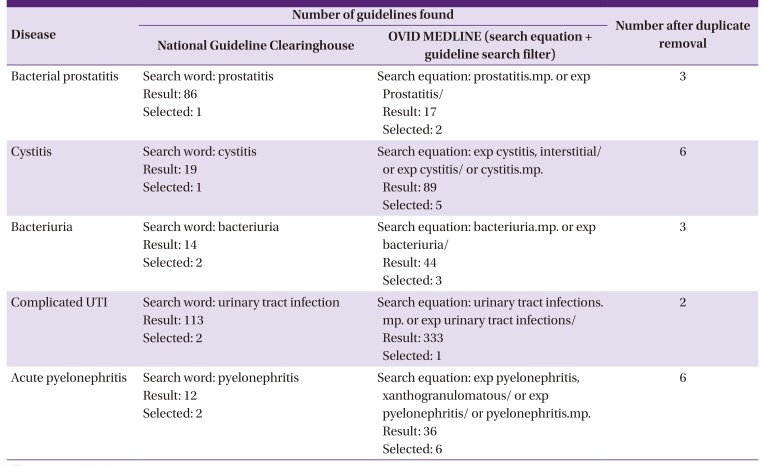
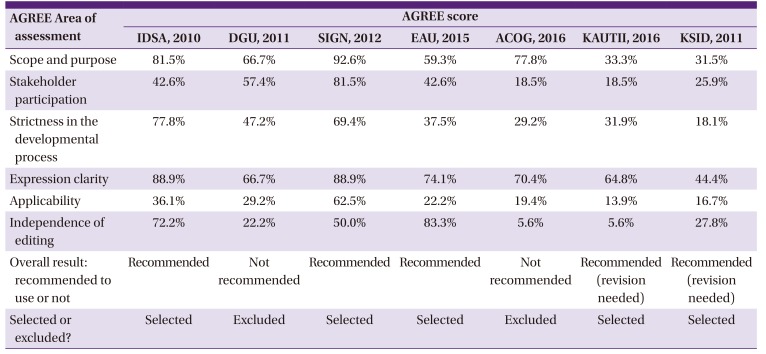

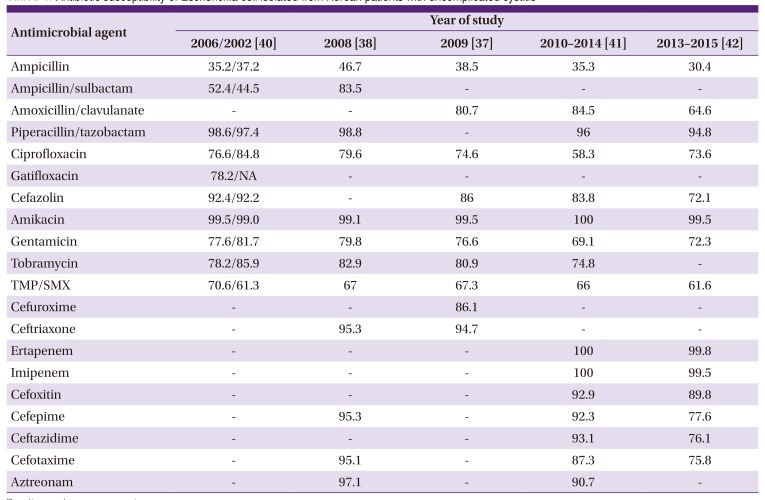
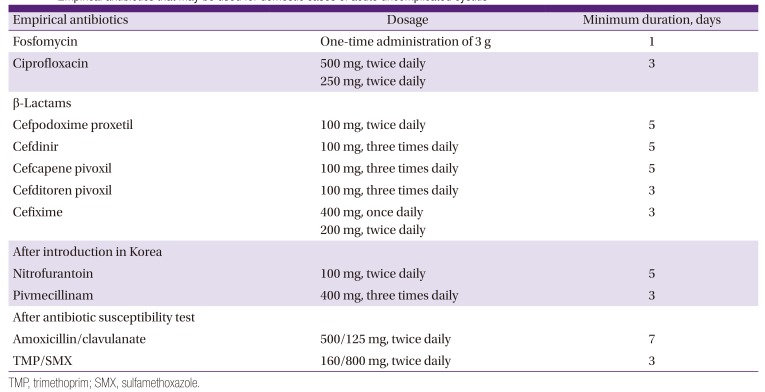


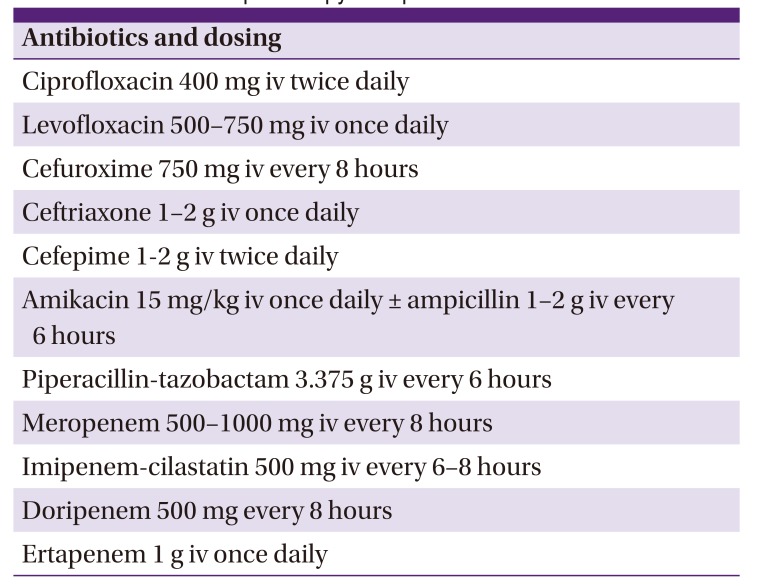




 PDF
PDF ePub
ePub Citation
Citation Print
Print




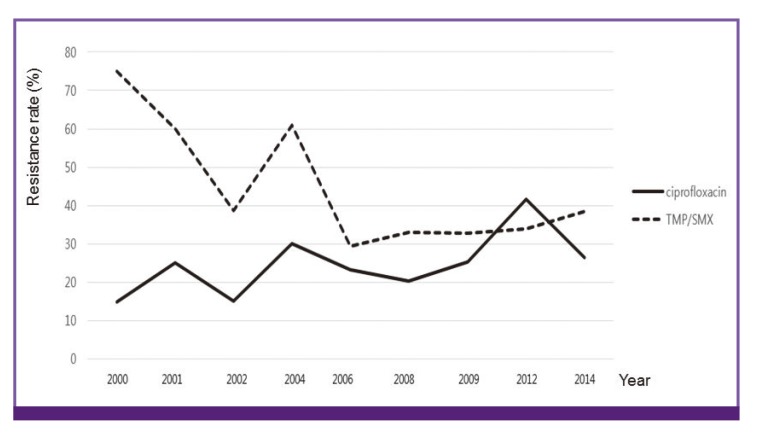
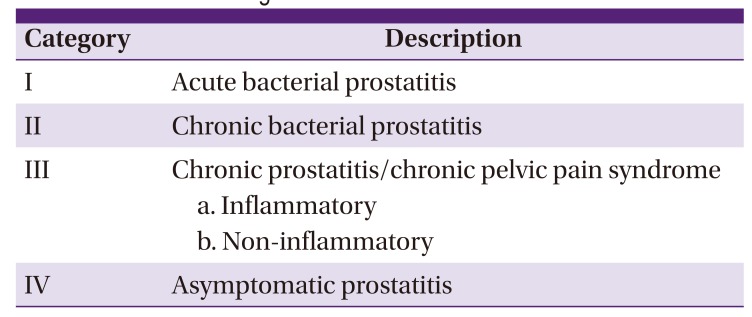
 XML Download
XML Download